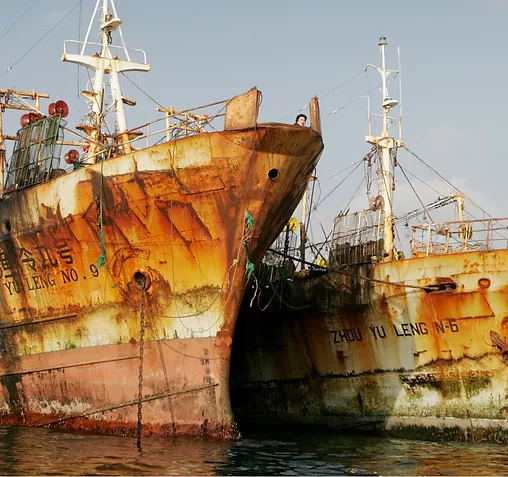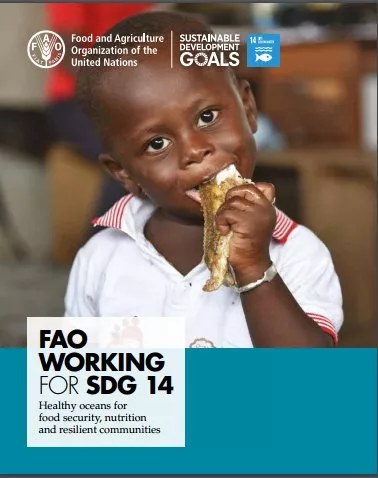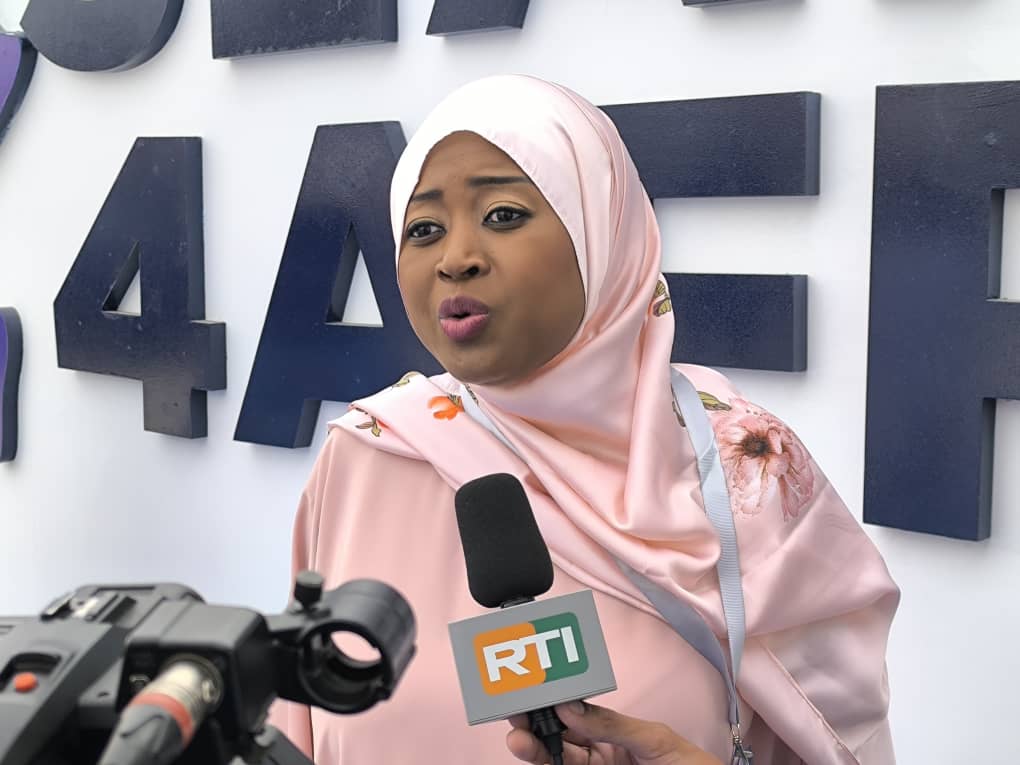West Africa is Losing $3.3 Billion Annually
Share

Chinese fishing vessels travel long distance to illegally fish in Africa’s waters Photo: Daily Mail
By Allieu M. Shaw
The cost to Africans for IUU fishing in Africa’s coastal waters is astronomical. Sub-Saharan countries in western Africa are losing a significant portion of their GDP to IUU fishing. Researchers estimate that sub-Saharan countries in West Africa are losing between $2.3 and $3.3 billion annually to IUU fishing, not including the value-add of the catch, while a minimal amount of $13 million is recovered through the Monitoring, Control, and Surveillance (MCS) system.
According to USAID, in 2012 Senegal reportedly lost $300 million or 2% of its GDP to IUU fishing. During the rebel incursion in 1997, Sierra Leone lost 8.8% of GDP, Liberia lost 5.5% of GDP, and Guinea lost 4% of its GDP, all to IUU fishing.
Globally, the World Bank estimates the economic loss from IUU fishing and poor fisheries governance to be between $50 and $100 billion each year.
In 2011, fisheries contributed $24 billion to the total African economy, representing 1.3% of Africa’s GDP while losing $24.5 billion to IUU fishing between 2010 and 2015. In 2011, Sub-Saharan western African countries earned only $400 million in revenues generated from legally selling foreign fishing rights.
Most of the losses were attributed to illegal fishing; however, a substantial amount was due to under-reporting of fish caught by legal and authorized fishing vessels originating from Eastern and Western European countries, Russia, China and South Korea, and from countries taking advantage of the Ebola crisis in Sierra Leone, Guinea, and Liberia. A U.N report estimated that Liberia lost about $50 billion to IUU fishing during the 14 year civil war.
According to the Overseas Development Institute (ODI), if governments in Africa could combat IUU fishing and build up national fleets and processing industries, they could potentially generate an additional $3.3 billion annually in extra wealth and create around 306,000 jobs.
Additional multiplier effects and impact on employment could be brought through value chain development.

The Consequences of Doing Nothing
Africa is at a crossroads in determining its future prospects for food security and nutrition, and sustainability of its Blue Economy. Consumption of fish products as a primary source of nutrition has outpaced production of fish resources due to environmental stressors such as changing demographic trends, climate change effects, habitat loss, invasive species, pollution, rising food prices, and overexploitation and depletion of the region’s marine resources by rouge non-state actors.
Based on the current demand to supply ratio, if steps are not taken to prevent further damage to the marine fish biodiversity, recovery of fish stocks for certain species of fish may be severely inhibited, which may require countries in Africa to fill the gap for fish products from foreign imports. This could exacerbate poverty and and social cohesion in some countries and ultimately affect the broader development agenda and balance of payment.
The effect of overfishing has become evident in some coastal communities in Africa. According to the FAO, over 40 populations of fish spices have gone extinct due to overexploitation. Since inventory or surveys of species are not regularly conducted in Africa, it is not certain which species are overexploited in ways which place the long-term sustainability of the populations and species at risk.
To effectively address the variety of complex socioeconomic issues facing fisheries management in western Africa, there needs to be a strong long-term commitment for reform by political decision-makers and a paradigm shift to an ecosystem-based approach to fisheries management which has been shown to be effective in other coastal countries.
A joint report issued by World Bank, the International Food Policy Research Institute (IFPRI), and the Food and Agriculture Organization of the United Nations (FAO) projects that globally, total fish supply will increase from 154 million tons in 2011 to 186 million tons in 2030.
In spite of the increase in fish supply at the global level, annual per capita fish consumption is projected to increase from 17.2 kilograms in 2010 to 18.2 kilograms in 2030. The trend in per capita consumption, however, varies across regions depending on demographic trends. In Africa, for example, the demand for fish and seafood products will increase significantly to 36% by 2030 up from 4% in 2000.
This high demand for seafood products will largely account for higher food prices with disproportionate effects on the urban poor populations as it is estimated that 43% of the region’s population will be urban in 2025.
Africa’s population continues to grow, albeit slowly. The population estimate is 1.704 billion by 2030 from the current 1.3 billion in 2017, 2.528 billion by 2050, and 4.468 billion people by 2100. This population growth will be attributed to the growing populations in a handful of countries in Africa led by Nigeria and followed by Angola, Burundi, Democratic Republic of Congo, Malawi, Mali, Niger, Somalia, Uganda, and United Republic of Tanzania and Zambia.
However, if the current trend of overexploitation of the marine fish stocks continues coupled with the rising demand for seafood products, it will risk catastrophe on many fronts: such as per-capita fish consumption will decline significantly at an annual rate of 1 percent or 5.6 kilograms by 2030, which could impact food security and nutrition and potentially derail the U.N’s Sustainable Development Goals (SDG) 1, 2, and 14 for 2030.
Hunger and poverty could become widespread as a result, and exacerbate existing socioeconomic and environmental disparities in Africa. According to UNICEF in 2016, 17.6 million children in sub-Saharan Africa suffered from acute malnutrition, 1 in 12 children died before the age of 5, 38% (59 million) of stunted children, 24% (9.8 million) of overweight children, and 27% (14 million) of wasted children under the age of 5 lived in Africa.
Poor nutrition in the first 1,000 days of a child’s life can lead to stunted growth, which is associated with impaired cognitive ability and reduced school and work performance. Stunting is irreversible because stunted children are not likely to recover height as they would weight.
In spite of the wealth generated by the oceans and the blue economy in Africa, Africa’s children are disproportionately affected by acute malnutrition, pneumonia, diarrhea and malaria, and roughly 1.3 million, or 40% of under-five deaths still occur as a result in sub-Saharan Africa.
Progress in the Making
The World Bank Group and its development partners has made substantial progress in helping vulnerable countries in Western Africa develop the legislative framework for conservation and recovery of fish biodiversity. According to some small-scale fishers in West Africa, there has been dramatic changes in the health of fish stocks as is evident in the significant progress being made in Liberia.
The programs has helped West African countries harness the power of the ocean in a commercially viable way. What is needed, however, is a strong commitment by the governments to improve the public sector, strengthen fishing rights for fishers, create the mechanisms to police their coasts, and capitalize on the oceans resources for sustainable development.
The West Africa Regional Fisheries Program (WARFP) program was initiated and approved by the International Development Assistance (IDA) and the World Bank in 2009 and implemented in 2010 in three 5-year phases aimed at:
(i) strengthening governance and management of the countries’ fisheries;
(ii) reducing illegal, unreported and unregulated (IUU) fishing; and
(iii) increasing the net value generated by fish resources and the proportion of that value captured by the countries.
Nine countries within the western Africa region were slated to participate in the program. Phase 1 is a 5 year project focused on strengthening governance and management of the countries’ fisheries. The first group of countries selected to participate in the first phase were Cabo Verde, Liberia, Senegal, and Sierra Leone. Subsequently Guinea-Bissau, Ghana, Mauritania, and Guinea were admitted into the program.
Phase 2 is a 5-year project focused on increasing the net value generated by fish resources and the proportion of that value captured by the countries. This phase of the program is significant to creating sustainable wealth for the region because a lions share of the fish caught in West Africa’s waters is not landed in the region, but rather is taken directly to foreign ports where further value is added and jobs are created for their own economy.
Phase 3 is a 5-year project aimed at reducing illegal, unreported and unregulated (IUU) fishing activities in West Africa. Most of the 1.6 million tons of fish legally captured in West African waters each year has an estimated wholesale value of $2.5 billion. However, the size and scale of illegal, unregulated, and unreported fishing in West African waters
Our mission and vision is in support of WARFP to create awareness of the program by advocating for and championing policies that promote good governance and transparency in fisheries management, and support for shared economic growth through collaborative partnerships with governments, investors, and civil society.

















